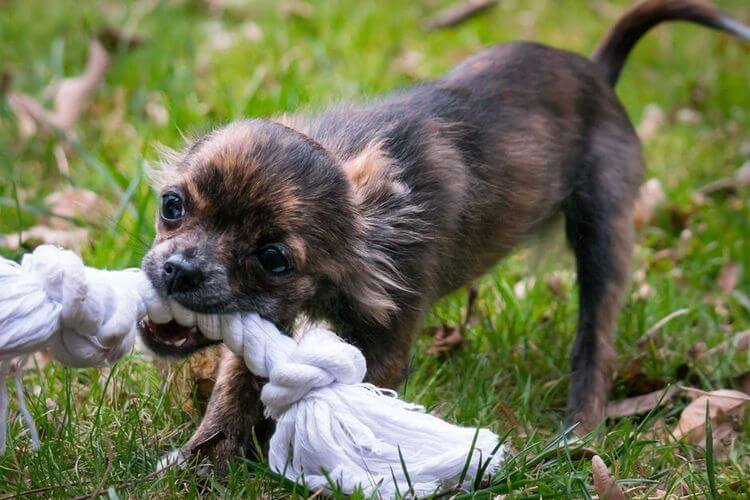Are you looking forward to a four-legged addition to the family, because you want a puppy to move in? Congratulations – you can look forward to an incredibly beautiful but exhausting time. Because there is a lot to learn! You can get help and advice at a dog school that offers puppy and young dog courses.
Puppy School: When, How Long, and Why?

A puppy play lesson is suitable for young dogs between the ages of nine and 16 weeks. Every puppy owner benefits from a visit: It is suitable for small and large dogs as well as for first-time dog owners and people who have already had dogs. Because in the puppy school every dog learns a lot for life: from contact with other dogs of different breeds to dealing with noises to sitting quietly next to fellow dogs.
In addition, in a good dog school, there are experiences such as walking on different surfaces, through tunnels, or rustling flutter belts. If a puppy gets to know these environmental stimuli in a controlled manner, he will develop more self-confidence in everyday life.
The two-legged friends also learn the basic rules for handling their dog – and much more. Because an experienced dog trainer gives valuable tips about individual communication with the puppy. This way, small misunderstandings can be quickly cleared up. Newbies, as well as experienced dog owners, benefit from this.
In some countries, attending a puppy school is compulsory. For example in the canton of Zurich in Switzerland for all puppies that reach over 45 cm shoulder height. But smaller dogs also benefit from good socialization and the numerous tips from the professionals.
What Happens in the Puppy School?
Often puppy courses are called “puppy play lessons”. That is why many new dog owners imagine that the puppies will have time to play together. This is not the case in a good dog school.
Every puppy school is different. We give an example of a varied training session: The human-dog teams come together in peace and quiet and several meters apart on a large, fenced-in area or meadow. In this way, the four-legged friends learn to sit quietly next to their human despite being distracted.
Meanwhile, people deal with learning theory or have the opportunity to ask questions about everyday life with their puppy. Then there is a task like practicing an abort signal. The dog trainer observes the respective teams and gives tips. In addition, the teams have the opportunity to deal with environmental stimuli at the stations that have been set up. Bottle boxes with corks or rustling tunnels are possible.
In between, the trainer enables dogs to play in teams of two for a few minutes each.
In the end, everyone gathers again for a short conversation. There is time to clarify open questions and to set exercises for the coming week.
How to Find a Good Dog School
Since “dog trainer” is not a protected job title, research the qualification of the trainer. Set a high value on non-violent and respectful handling of the dogs. Shouting at or suppressing them is taboo.
Since the dogs are not supposed to play with each other indiscriminately, puppies of different breeds and sizes are allowed to be present. A total of five to a maximum of eight dogs is a good number for training together. For free play, the trainer selects dogs that are physically in harmony with each other. Turn around if you want any number of dogs of different sizes to meet during the puppy school according to the motto “they make it up for themselves”.
Because negative experiences like the uncontrolled scuffling of strong bullies and delicate sensitive little ones in the puppy age shape for life.
A good puppy school offers a coherent concept with a lot of variety. If you want to be on the safe side, ask your four-legged friend whether he or she can watch a puppy playgroup in advance and without a dog. A reputable dog school will allow this. So you can get an idea of the atmosphere and the training methods.
What Does It Cost to Attend a Puppy School?
The prices for attending the puppy play hour vary, depending on the region and dog school, between 10 and 25 euros per hour. Usually, courses with fewer participants are more expensive, but the investment is worthwhile. Because here you receive more intensive care and thus tailor-made tips for working with your animal companion.
Tip: Many dog schools offer subscriptions or package prices for puppy play lessons and young dog courses in favorable conditions. Important: The puppy should be vaccinated and dewormed – bring proof of this with you to the puppy school.
At a Glance: Advantages of the Puppy School
- Socialization: The puppy learns how to deal with other dogs (e.g. bite inhibition);
- Embossing: The dog trainer lets the human-dog teams discover a lot;
- Practical training in a challenging environment;
- General tips about dog training in everyday life;
- Individual advice on everything to do with human-dog communication from experts;
- Good opportunity to get to know other dog owners.

